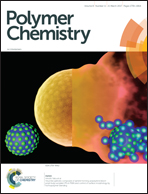Controlled polymerization of isoprene promoted by a type of hemilabile X![[double bond, length as m-dash]](https://www.rsc.org/images/entities/char_e001.gif) PN3 (X = O, S) ligand supported cobalt(ii) complexes: the role of a hemilabile donor on the level of control†
PN3 (X = O, S) ligand supported cobalt(ii) complexes: the role of a hemilabile donor on the level of control†
Abstract
Cobalt dichloride complexes (Co1–Co9) carrying a novel type of hemilabile donor PN3 (L1–L3) or X![[double bond, length as m-dash]](https://www.rsc.org/images/entities/char_e001.gif) PN3 (L4–L6, X = O; L7–L9, X = S) are reported as precursors for controlled polymerization of isoprene. The nature of the hemilabile donor (P, O and S) determines the coordination chemistry of the complexes. X-ray analysis reveals that the P-ligated complex Co3 has two nuclear centres, with one being bis-chelated by L3 and the other with four chlorides. The complex Co4 is formed through N,N,O(
PN3 (L4–L6, X = O; L7–L9, X = S) are reported as precursors for controlled polymerization of isoprene. The nature of the hemilabile donor (P, O and S) determines the coordination chemistry of the complexes. X-ray analysis reveals that the P-ligated complex Co3 has two nuclear centres, with one being bis-chelated by L3 and the other with four chlorides. The complex Co4 is formed through N,N,O(![[double bond, length as m-dash]](https://www.rsc.org/images/entities/char_e001.gif) P) tridentate coordination, and the S donor for complex Co7, however, lies out of the coordination sphere. Activated by AlEt2Cl, all complexes are highly active with nearly full monomer conversion within 2 h and have a controlled cis-1,4 selectivity at 77.5–99.0% for isoprene polymerization. The P-ligated complexes (Co1–Co3) have higher cis-1,4 selectivities up to 99.0%, albeit a typical molecular weight controlled characteristic is not found. The generated polymers for Co4–Co9 all exhibit well-controlled molecular weights up to 29.1 × 104 and narrow molecular weight distributions (PDI < 1.25). The kinetic studies reveal that the catalyst systems follow a typical living mechanism. Correlating the hemilabile donor with the catalytic performances shows that the presence of the P
P) tridentate coordination, and the S donor for complex Co7, however, lies out of the coordination sphere. Activated by AlEt2Cl, all complexes are highly active with nearly full monomer conversion within 2 h and have a controlled cis-1,4 selectivity at 77.5–99.0% for isoprene polymerization. The P-ligated complexes (Co1–Co3) have higher cis-1,4 selectivities up to 99.0%, albeit a typical molecular weight controlled characteristic is not found. The generated polymers for Co4–Co9 all exhibit well-controlled molecular weights up to 29.1 × 104 and narrow molecular weight distributions (PDI < 1.25). The kinetic studies reveal that the catalyst systems follow a typical living mechanism. Correlating the hemilabile donor with the catalytic performances shows that the presence of the P![[double bond, length as m-dash]](https://www.rsc.org/images/entities/char_e001.gif) O (Co4–Co6) or P
O (Co4–Co6) or P![[double bond, length as m-dash]](https://www.rsc.org/images/entities/char_e001.gif) S (Co7–Co9) moiety in the auxiliary ligand is essential for the living nature; by trapping the Al species, the moiety –HN–P
S (Co7–Co9) moiety in the auxiliary ligand is essential for the living nature; by trapping the Al species, the moiety –HN–P![[double bond, length as m-dash]](https://www.rsc.org/images/entities/char_e001.gif) X (X = O, S) makes propagating chain transfer to Al impossible, which was responsible for irreversible reaction in most dienes polymerization. The possible reversible coordination of the allylic end of the propagating chain to Al is proposed for the dual cis-1,4 and 3,4 selectivities for Co4–Co9. This study represents the first example of cobalt catalyzed molecular weight and microstructure controlled polymerization of isoprene ever known.
X (X = O, S) makes propagating chain transfer to Al impossible, which was responsible for irreversible reaction in most dienes polymerization. The possible reversible coordination of the allylic end of the propagating chain to Al is proposed for the dual cis-1,4 and 3,4 selectivities for Co4–Co9. This study represents the first example of cobalt catalyzed molecular weight and microstructure controlled polymerization of isoprene ever known.
![Graphical abstract: Controlled polymerization of isoprene promoted by a type of hemilabile X [[double bond, length as m-dash]] PN3 (X = O, S) ligand supported cobalt(ii) complexes: the role of a hemilabile donor on the level of control](/en/Image/Get?imageInfo.ImageType=GA&imageInfo.ImageIdentifier.ManuscriptID=C7PY00252A&imageInfo.ImageIdentifier.Year=2017)


 Please wait while we load your content...
Please wait while we load your content...
![[double bond, length as m-dash]](https://www.rsc.org/images/entities/h2_char_e001.gif) PN3 (X = O, S) ligand supported cobalt(II) complexes: the role of a hemilabile donor on the level of control
PN3 (X = O, S) ligand supported cobalt(II) complexes: the role of a hemilabile donor on the level of control